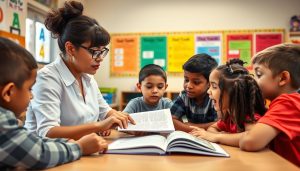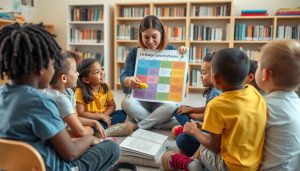In this comprehensive guide, we’ll explore practical approaches to building stronger relationships with families through intentional communication practices. You’ll discover how to overcome common barriers, leverage digital tools, and develop the essential teacher skills needed to connect with families from all backgrounds.
Why Effective Communication with Families Matters for Teacher Skills
Building strong partnerships through effective communication skills
Research consistently shows that family engagement is a powerful predictor of student achievement. According to a Harvard Family Research Project study, students with involved parents are more likely to earn higher grades, have better social skills, and show improved behavior regardless of socioeconomic background.
Developing strong teacher skills in family communication offers multiple benefits:
- Increased student achievement and classroom engagement
- Reduced behavioral issues and improved attendance
- Greater support for learning activities at home
- Enhanced teacher credibility and professional reputation
- More effective problem-solving when challenges arise
When teachers prioritize effective communication with families, they create a support network that extends learning beyond classroom walls. This collaborative approach helps students see education as a valued priority across all areas of their lives.
As one middle school teacher noted, “Once I improved my communication skills with parents, I saw an immediate difference in how students approached assignments. They knew we were all on the same team.”
Common Barriers to Effective Communication with Families
Before developing stronger communication strategies, it’s important to recognize the obstacles that might be preventing meaningful connections with families. Understanding these barriers is an essential teacher skill that allows you to proactively address potential challenges.
Language and Cultural Differences
Many school communities serve families who speak different languages or come from diverse cultural backgrounds. These differences can create misunderstandings about educational expectations, appropriate communication channels, and even the role of parents in education.
Developing teacher skills to navigate cultural differences requires both awareness and adaptability. Simple translations may not be enough if cultural context is missing from your communications.
Time Constraints and Scheduling Conflicts
Both teachers and parents face significant time pressures. Many families work multiple jobs or have irregular schedules that make traditional parent-teacher conferences difficult to attend. Similarly, teachers often juggle numerous responsibilities that limit their availability.
Finding flexible approaches to communication is a valuable teacher skill that acknowledges these real-world constraints while still prioritizing connection.
Technology Access and Digital Literacy
While digital tools have expanded communication possibilities, they’ve also created new barriers. Not all families have reliable internet access, devices, or the technical skills needed to engage with digital platforms. Assuming digital accessibility can inadvertently exclude important voices from the conversation.
Previous Negative Experiences
Many parents carry their own negative school experiences that make them hesitant to engage with teachers. Similarly, previous challenging interactions with families can make teachers apprehensive about reaching out. Breaking these cycles requires intentional relationship-building.
Recognizing these barriers is the first step toward developing the teacher skills needed to overcome them. By acknowledging these challenges directly, you can create more inclusive communication strategies that reach all families.
Core Principles of Effective Communication for Teacher Skills Development

Active listening is a foundational teacher skill for effective communication
Developing strong teacher skills in communication begins with understanding and applying these fundamental principles:
Consistency
Regular, predictable communication helps families know what to expect and when. Establishing consistent patterns—whether weekly newsletters, monthly check-ins, or regular updates—builds trust and reliability.
Clarity
Clear, jargon-free language ensures your message is understood by all families. Avoid educational terminology that might be unfamiliar, and focus on specific, actionable information rather than generalizations.
Positivity
Beginning relationships with positive interactions creates a foundation of goodwill. Sharing student successes and strengths before addressing challenges helps maintain a constructive partnership.
Cultural Responsiveness
Recognizing and respecting cultural differences in communication styles, family structures, and educational values demonstrates your commitment to inclusive practices.
Two-Way Dialogue
Effective communication isn’t just about disseminating information—it’s about creating opportunities for families to share their insights, ask questions, and contribute to the educational conversation.
Accessibility
Providing multiple communication channels ensures all families can engage in ways that work for their circumstances, whether through digital platforms, phone calls, written notes, or in-person meetings.
These principles form the foundation of effective communication strategies and are essential teacher skills to develop. By consistently applying these concepts, you’ll create an environment where meaningful family partnerships can flourish.
Enhance Your Communication Skills
Looking to develop your teacher skills in family communication? Our comprehensive course provides practical strategies you can implement immediately.
Practical Strategies for Effective Communication with Diverse Families
Implementing effective communication requires specific teacher skills and strategies that address the diverse needs of your school community. Here are practical approaches you can adapt to your unique classroom context:
1. Establish Communication Preferences Early
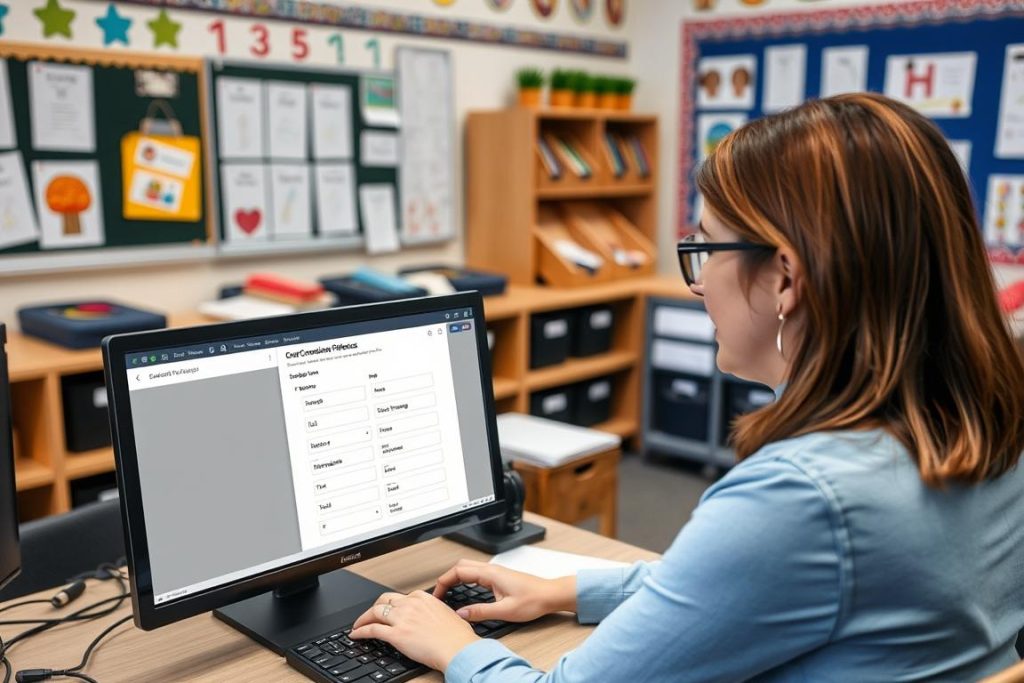
Gathering family communication preferences is an essential teacher skill
One of the most valuable teacher skills is knowing how to gather information about family communication preferences at the beginning of the school year. Create a simple form that asks:
- Preferred contact method (email, phone, text, app, written notes)
- Best times to reach them
- Language preferences and translation needs
- Any specific concerns or information they want you to know
This proactive approach demonstrates respect for families’ time and circumstances while giving you valuable information to tailor your communication approach.
2. Leverage Multiple Communication Channels
Effective communication requires using diverse channels to reach all families. Developing teacher skills across multiple platforms ensures no family is left out of important conversations.
Digital Options:
- Class websites or blogs with regular updates
- Email newsletters with important dates and information
- Educational apps like ClassDojo, Remind, or Seesaw
- Virtual conference options for families with scheduling constraints
Traditional Methods:
- Printed newsletters or calendars sent home regularly
- Phone calls for more personal conversations
- Home-school journals for ongoing dialogue
- In-person meetings with flexible scheduling options
The most effective approach combines both digital and traditional methods, recognizing that different families have different access and preferences. This flexibility is a key teacher skill in today’s diverse educational landscape.
3. Practice Cultural Responsiveness
Cultural responsiveness is among the most important teacher skills for effective communication. This involves understanding how cultural backgrounds influence communication styles and educational expectations.
- Learn about the cultural makeup of your classroom community
- Avoid assumptions about family structures or parental roles
- Provide translated materials whenever possible
- Consider cultural perspectives on education, authority, and appropriate communication
- Invite cultural sharing as part of your classroom community
As noted in research from Colorín Colorado, “When schools honor and recognize families’ cultural backgrounds, communication becomes more effective and family engagement increases.”
4. Balance Positive and Constructive Communication
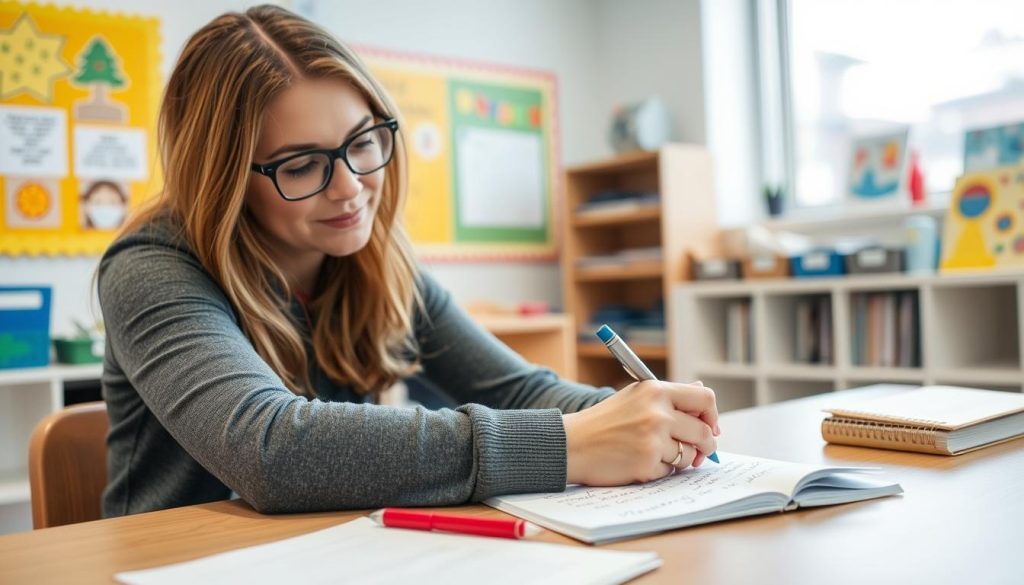
Balancing positive and constructive feedback is a crucial teacher skill
Many teachers primarily contact families when there are problems to address. Developing the teacher skill of regular positive communication creates a more balanced relationship that makes difficult conversations easier when they’re necessary.
Positive Communication Ideas:
- “Good news” calls or emails highlighting student successes
- Photos or videos of classroom activities and achievements
- Positive postcards mailed home for special accomplishments
- Weekly “spotlight” features celebrating different students
Constructive Communication Approaches:
- Frame challenges as opportunities for growth
- Use “I noticed…” statements rather than judgments
- Offer specific, actionable suggestions
- Always include strengths alongside areas for improvement
Aim for a 3:1 ratio of positive to constructive communications to build a foundation of trust and partnership.
Digital Tools for Enhancing Effective Communication Teacher Skills
Technology offers powerful opportunities to strengthen your communication teacher skills. These digital tools can help streamline your approach while reaching more families:
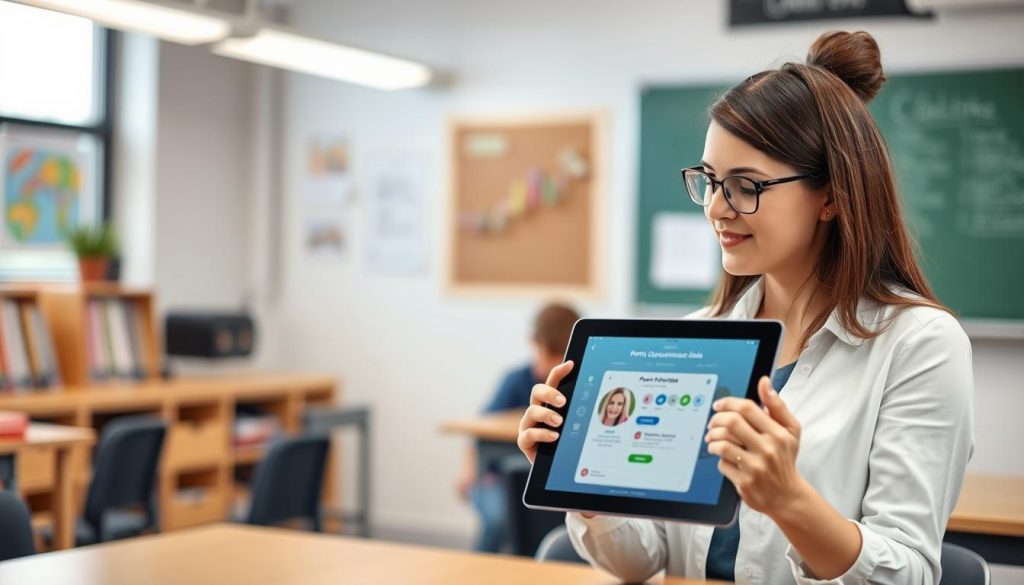
Digital tools can enhance teacher skills in family communication
Classroom Management Apps
Examples: ClassDojo, Seesaw, Remind
Benefits: These platforms allow for real-time updates, photo and video sharing, private messaging, and translation features. They create digital portfolios of student work that families can access anytime.
Teacher Skills: Learning to post consistently, share meaningful content, and respond promptly to messages.
Video Conferencing Tools
Examples: Zoom, Google Meet, Microsoft Teams
Benefits: These tools enable virtual conferences, recorded presentations for families who can’t attend live events, and screen sharing for discussing student work.
Teacher Skills: Managing virtual meetings professionally, creating engaging presentations, and troubleshooting basic technical issues.
Newsletter and Email Platforms
Examples: Smore, Mailchimp, Google Classroom updates
Benefits: These services help create visually appealing newsletters, track engagement, schedule communications, and organize content effectively.
Teacher Skills: Writing concise, informative content, maintaining consistent scheduling, and designing user-friendly layouts.
Translation Services
Examples: TalkingPoints, Google Translate, Microsoft Translator
Benefits: These tools help bridge language barriers by translating communications into families’ preferred languages, making information more accessible.
Teacher Skills: Writing clear messages that translate well, verifying translation accuracy, and using culturally responsive language.
Scheduling Tools
Examples: Calendly, SignUpGenius, Google Calendar
Benefits: These platforms simplify the process of scheduling conferences, volunteer opportunities, and other family engagement activities.
Teacher Skills: Setting appropriate availability, managing your calendar efficiently, and sending helpful reminders.
Digital Feedback Platforms
Examples: Google Forms, SurveyMonkey, Microsoft Forms
Benefits: These tools allow you to gather family input, conduct needs assessments, and collect feedback on communication effectiveness.
Teacher Skills: Creating clear questions, analyzing response data, and implementing changes based on feedback.
While these digital tools can significantly enhance your communication teacher skills, remember that technology should supplement, not replace, personal connection. The most effective communicators combine digital efficiency with authentic relationship-building.
For teachers looking to develop their digital communication skills, Credits for Teachers offers professional development opportunities that can help you master these platforms while earning continuing education credits.
Navigating Difficult Conversations: Advanced Effective Communication Teacher Skills
Even with strong communication practices, challenging conversations with families are inevitable. Developing advanced teacher skills for these situations helps maintain productive partnerships even during difficult moments.

Handling difficult conversations requires advanced teacher skills in communication
Preparation Strategies
Effective difficult conversations begin with thorough preparation, a key teacher skill that prevents miscommunication:
- Gather specific examples and documentation before the conversation
- Anticipate questions or concerns the family might raise
- Plan your key points but remain flexible in your approach
- Consider cultural factors that might influence the conversation
- Choose an appropriate setting that ensures privacy and comfort
During the Conversation
How you conduct yourself during challenging discussions demonstrates your professional teacher skills:
Do:
- Begin with a positive observation about the student
- Use “I” statements to express concerns without blame
- Listen actively without interrupting
- Acknowledge emotions (both theirs and yours)
- Focus on solutions and next steps
Avoid:
- Defensive responses to criticism
- Educational jargon that creates barriers
- Comparing the student to classmates
- Making promises you can’t keep
- Rushing to fill silences in the conversation
Follow-Up Practices
What happens after difficult conversations is just as important as the discussion itself:
- Send a brief summary of what was discussed and agreed upon
- Establish a timeline for next steps and check-ins
- Follow through consistently on any commitments made
- Provide positive updates when improvements occur
- Reflect on the conversation to improve your approach next time
“The most skilled teachers view difficult conversations not as confrontations but as collaborative problem-solving opportunities that strengthen relationships when handled well.”
– Dr. Karen Mapp, Harvard Graduate School of Education
Developing these advanced teacher skills takes practice and reflection. Consider role-playing challenging scenarios with colleagues to build confidence in your approach.
Building Relationships Through Effective Communication Teacher Skills
At its core, effective communication is about relationship-building. These strategies help create meaningful connections with families that support student success:
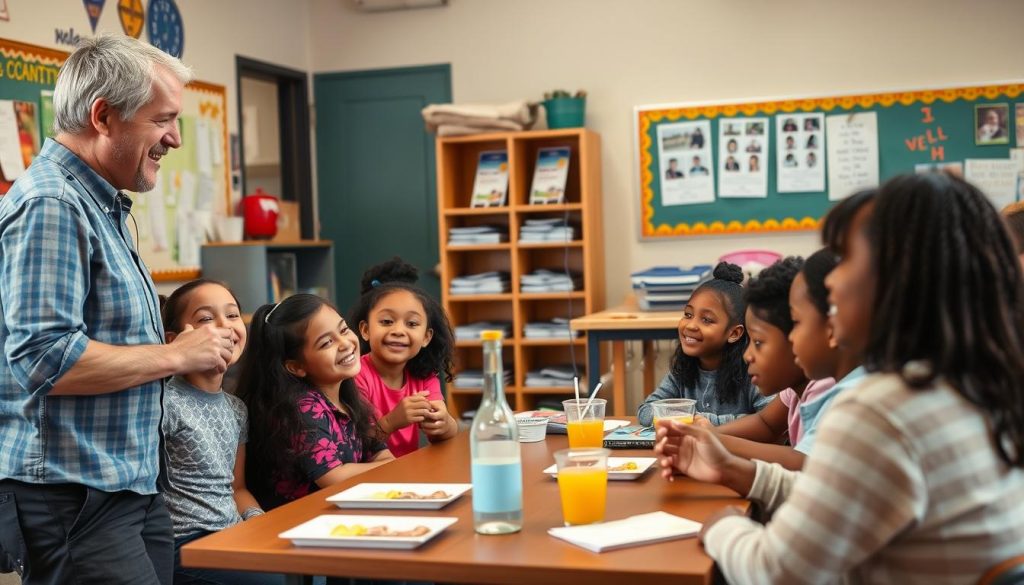
Building relationships is the foundation of effective communication teacher skills
Start Early and Positively
First impressions matter significantly in family relationships. Proactive teacher skills include:
- Welcome calls or emails before the school year begins
- Personal notes introducing yourself and your teaching philosophy
- Beginning-of-year questionnaires that invite family input
- An open house or virtual tour of your classroom
- A clear explanation of your communication approach and availability
Create Opportunities for Informal Interaction
Relationships flourish in casual settings that allow for authentic connection:
- Morning greeting routines that welcome families into the classroom
- Family breakfast events with minimal agenda
- Cultural celebration potlucks that honor diversity
- Student-led showcases of classroom learning
- Virtual “coffee chats” for families unable to visit in person
Practice Empathetic Listening
One of the most valuable teacher skills is the ability to truly hear family perspectives:
- Ask open-ended questions that invite sharing
- Validate concerns without rushing to solutions
- Notice non-verbal cues that might indicate discomfort or confusion
- Reflect back what you’ve heard to ensure understanding
- Follow up on previous conversations to show you remember and care
Honor Family Expertise
Recognizing families as experts on their children creates more balanced partnerships:
- Ask for insights about student interests, strengths, and needs
- Invite families to share cultural knowledge or special skills
- Incorporate family suggestions into your teaching approach
- Acknowledge the valuable learning that happens at home
- Express gratitude for their partnership and contributions
These relationship-building teacher skills create a foundation of trust that supports all other communication efforts. When families feel genuinely respected and valued, they’re more likely to engage actively in their child’s education.
Develop Your Family Communication Skills
Looking for more strategies to strengthen your teacher skills in family communication? Our comprehensive course offers practical techniques you can implement immediately.
Measuring the Success of Your Effective Communication Teacher Skills
How do you know if your communication efforts are working? Developing assessment teacher skills helps you evaluate and improve your approach:
Evaluating commuacher skill
Quantitative Indicators
These measurable metrics can help you track communication effectiveness:
- Response rates to messages and invitations
- Attendance at school events and conferences
- Completion of home learning activities
- Number of family-initiated contacts
- Participation in volunteer opportunities
Qualitative Feedback
Beyond numbers, these indicators provide deeper insights:
- Quality and tone of family responses
- Willingness to share concerns or ask questions
- Specific feedback on communication methods
- Observations about family comfort in school settings
- Changes in student attitudes about school-home connections
Formal Assessment Tools
Consider using these structured approaches to gather feedback:
- Mid-year and end-of-year surveys about communication preferences
- Quick polls after specific communication initiatives
- Feedback cards at family events
- Student interviews about home-school communication
- Colleague observations and suggestions
Reflection Questions
Regular self-assessment is a valuable teacher skill for communication improvement:
Ask yourself: “Am I reaching all families or just the most accessible ones? Are my communications primarily positive or problem-focused? Do families initiate contact comfortably? How quickly do I respond to family communications? What feedback have I received about my approach?”
Use this assessment data to continuously refine your communication teacher skills. Remember that different strategies work for different communities, so be willing to adapt your approach based on what you learn.
Case Studies: Effective Communication Teacher Skills in Action
These real-world examples demonstrate how teachers have successfully applied effective communication strategies to strengthen family partnerships:
Elementary School: Weekly Preview Videos
Challenge: Families had limited understanding of classroom learning and how to support it at home.
Solution: A third-grade teacher created brief (2-3 minute) weekly videos previewing upcoming learning topics, suggested home activities, and important dates. Videos were shared via a class app with translation options.
Teacher Skills Applied: Digital communication, clear explanations, consistency, accessibility
Results: 85% of families regularly viewed the videos, home learning participation increased by 40%, and families reported feeling more connected to classroom activities.
Middle School: Communication Menu
Challenge: Diverse family preferences made it difficult to reach everyone effectively.
Solution: A teaching team created a “communication menu” where families selected their preferred methods, frequency, and topics of communication. Teachers used a tracking system to ensure all families received information through their chosen channels.
Teacher Skills Applied: Flexibility, organization, responsiveness, inclusivity
Results: Parent conference attendance increased from 62% to 89%, and teachers reported more balanced communication across all families rather than frequent contact with just a few.
High School: Student-Led Communication
Challenge: Declining family engagement as students got older.
Solution: An English teacher implemented student-led communication where teens created monthly newsletters, prepared for and led conferences, and facilitated home discussions about their learning goals.
Teacher Skills Applied: Student empowerment, structured guidance, positive framing
Results: Family engagement increased by 35%, students reported greater ownership of their learning, and the quality of family-teacher interactions improved significantly.
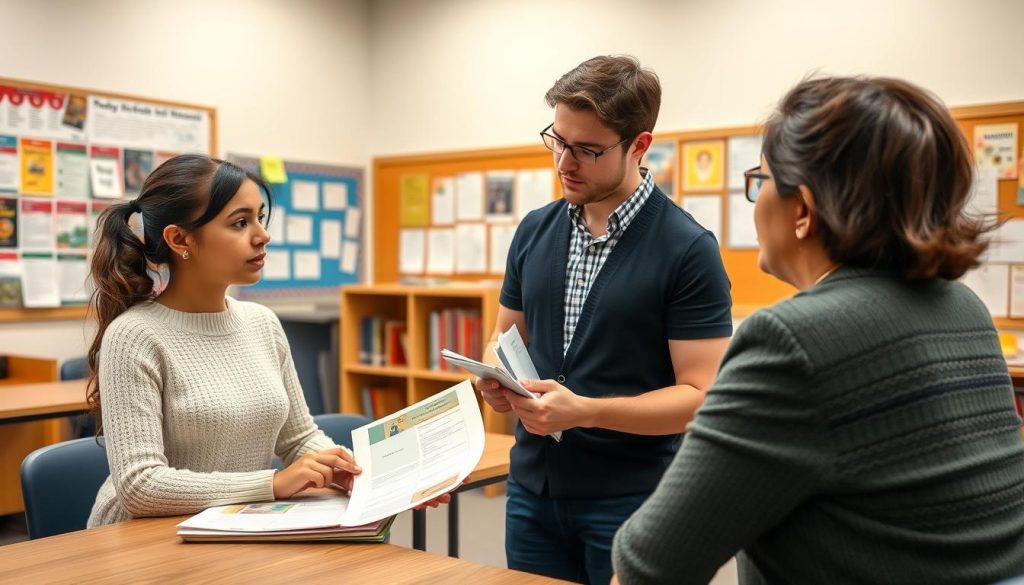
Student-led communication builds teacher skills and student ownership
These case studies highlight how teacher skills in communication can be adapted to different grade levels and community needs. The most successful approaches share common elements: consistency, accessibility, positivity, and responsiveness to family preferences.
Professional Development for Effective Communication Teacher Skills
Strengthening your communication skills is an ongoing professional journey. These resources can support your growth:
Formal Learning Opportunities
Courses and Workshops
Structured professional development provides focused skill-building in specific communication areas. Credits for Teachers offers specialized courses in family communication that can enhance your teacher skills while earning continuing education credits.
Their Communicating with Parents and Families course specifically addresses many of the strategies discussed in this article.
Professional Learning Communities
Collaborating with colleagues provides opportunities to share strategies, troubleshoot challenges, and receive feedback on your communication approach. Consider forming a study group focused specifically on family engagement practices.
Self-Directed Learning
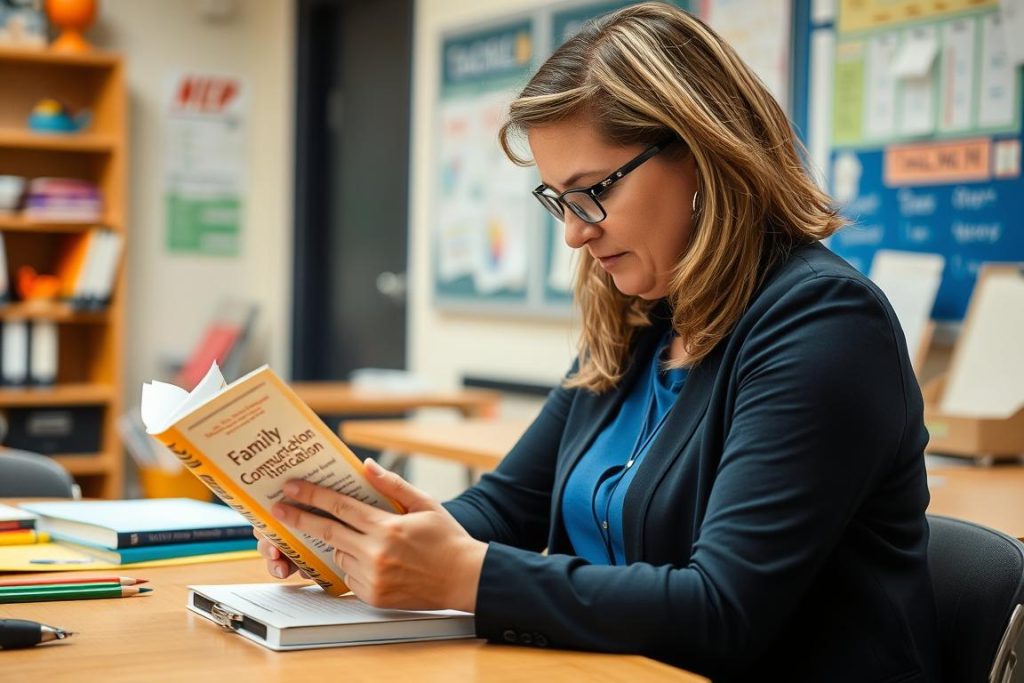
Ongoing learning is essential for developing teacher skills in communication
Recommended Reading
- “Beyond the Bake Sale: The Essential Guide to Family-School Partnerships” by Henderson, Mapp, Johnson, and Davies
- “Powerful Partnerships: A Teacher’s Guide to Engaging Families” by Karen Mapp, Ilene Carver, and Jessica Lander
- “Building Powerful Learning Relationships: A Practical Guide to Parent and Family Engagement” by Patricia Edwards
Digital Resources
- Webinars from organizations like Edutopia and Teaching Tolerance
- Podcasts such as “Teachers Aid” and “Cult of Pedagogy”
- Teacher blogs focused on family engagement strategies
- Social media groups dedicated to home-school partnerships
Reflective Practice
Perhaps the most powerful professional development comes through intentional reflection on your own practice:
- Keep a communication journal documenting what works and what doesn’t
- Record and review your own parent conferences (with permission)
- Invite trusted colleagues to observe and provide feedback
- Analyze patterns in family responses to different approaches
- Set specific communication goals and track your progress
Investing in these professional development opportunities demonstrates your commitment to strengthening this essential aspect of your teaching practice. As you enhance your teacher skills in communication, you’ll see benefits across all areas of your professional work.
Take Your Communication Skills to the Next Level
Ready to transform your approach to family communication? Our comprehensive course offers research-based strategies, practical tools, and personalized guidance.
Conclusion: The Ongoing Journey of Effective Communication
Developing effective communication with families is not a destination but a continuous journey of growth and adaptation. As you strengthen your teacher skills in this area, you’ll discover that meaningful family partnerships transform not only student outcomes but also your own professional satisfaction.
Remember that communication excellence doesn’t mean perfection. It means consistent effort, genuine care, and willingness to learn from both successes and missteps. Every positive interaction builds trust, and every challenge offers an opportunity to refine your approach.
The strategies outlined in this guide provide a foundation, but the most powerful communication teacher skills develop through your own authentic practice and reflection. As you implement these approaches, you’ll develop a personalized style that resonates with your unique school community.
By prioritizing effective communication with families, you’re not just fulfilling a professional responsibility—you’re creating a powerful support network that enhances student learning and well-being. This investment of time and energy yields dividends throughout your teaching career and makes a lasting difference in the lives of your students.
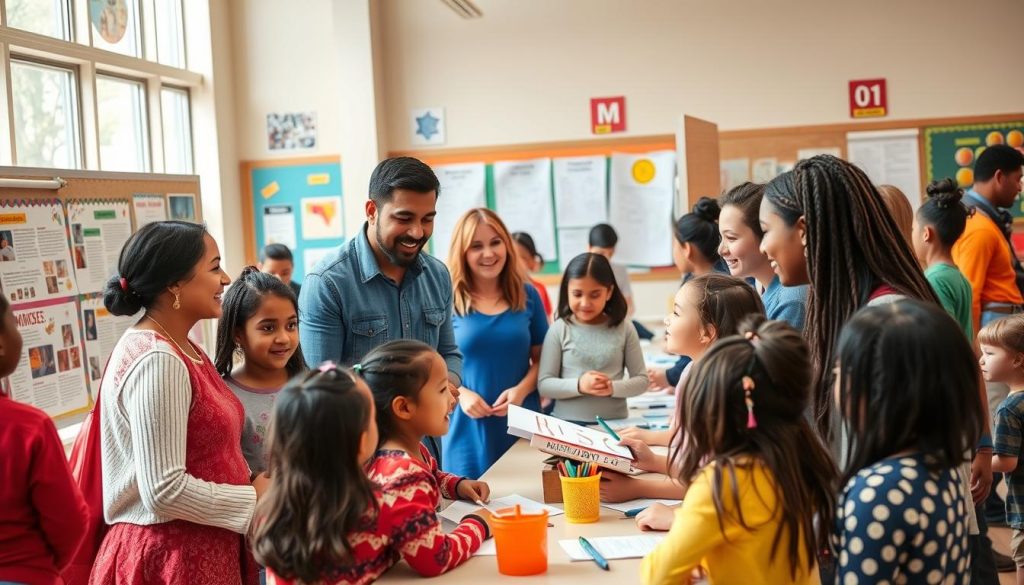
Effective communication creates lasting partnerships between teachers and families
Continue Your Professional Growth
Ready to enhance your teacher skills in family communication? Explore our comprehensive resources and courses designed specifically for K12 educators.



